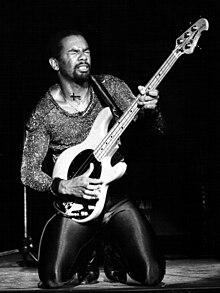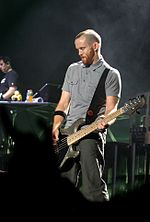| This article needs additional citations for verification. Please help improve this article by adding citations to reliable sources. Unsourced material may be challenged and removed. Find sources: "Music Man StingRay" – news · newspapers · books · scholar · JSTOR (March 2023) (Learn how and when to remove this message) |
| StingRay | |
|---|---|
 An Ernie Ball Music Man StingRay An Ernie Ball Music Man StingRay | |
| Manufacturer | Ernie Ball Music Man |
| Period | 1976 — present |
| Construction | |
| Body type | Solid |
| Neck joint | Bolt-on, Neck-through (as of 2015) |
| Woods | |
| Body | Ash, alder, basswood |
| Neck | Maple |
| Fretboard | Fretted: maple, rosewood, ebony Fretless: pao ferro (lined and unlined options available) |
| Hardware | |
| Bridge | Fixed |

The Music Man StingRay is an electric bass by Music Man, introduced in 1976.
History
Designed by Leo Fender, Tom Walker, and Sterling Ball, the StingRay bass appeared in 1976 and, though somewhat similar to a Fender Precision Bass, had a number of distinctive features.
The original Stingray design employs a single humbucking pickup placed near the bridge for a tighter sound, and an active pre-amp powered by a 9-volt battery. Early iterations of this preamp came with a 2-band EQ (bass and treble), later augmented by an optional third band (midrange), and piezo pickups located in the bridge saddles. The StingRay's active preamp was sealed in epoxy to avoid reverse engineering of the technology which came to be synonymous with the StingRay bass.
Since Music Man was purchased by Ernie Ball Inc. in 1984, a number of new features and options have been added to the StingRay range. Dual humbucking pickups were introduced in the early 2000s. A five-string variant of the StingRay has become common, in some spaces even outselling the tradition four-string offering.
The StingRay's hardware varies from that of more traditional Fender-style electric basses in several ways. Angled string pull on the headstock is reduced by a distinctive "3+1" design, with three tuning machines on top and one on the bottom. Its six-bolt neck plate supplies more body to neck contact than the more common four-bolt arrangement, with the extra rigidity providing further body sustain. The StingRay is offered in both string through body and top load stringing depending on specification.
The StingRay line has traditionally featured an ash body construction along with a maple neck and either a maple or rosewood fingerboard, finished with an oil coat, as opposed to hard lacquer finishes as used by Fender. In recent years, the roasted maple neck option has become popular, due to the wood's beautiful aesthetics and its higher resistance to varying humidity. Alongside this, a fretless Pau Ferro fingerboard has become increasingly popular.
Notable players


- Benjamin Orr of The Cars
- Bernard Edwards of Chic
- Louis Johnson of Michael Jackson and the Brothers Johnson
- Paul Denman of Sade
- Pino Palladino of D'Angelo, the John Mayer Trio, the Who, and others
- Flea of the Red Hot Chili Peppers
- Max Green of Escape The Fate
- Shavo Odadjian of System Of A Down
- Jeff Ament of Pearl Jam
- Rex Brown of Pantera
- Justin Chancellor of Tool
- Johnny Christ of Avenged Sevenfold
- Tim Commerford of Rage Against the Machine
- John Deacon of Queen
- Dave 'Phoenix' Farrell of Linkin Park
- Mark Hoppus of Blink 182
- Jason Newsted formerly of Metallica
- Jaime Preciado of Pierce the Veil
- Trent Reznor of Nine Inch Nails
- Robert Trujillo of Metallica
- Cliff Williams of AC/DC
- Tony Levin, of King Crimson, Peter Gabriel, John Lennon, and others
- Dougie Thomson of Supertramp
References
- "StingRay". Ernie Ball Music Man basses. Retrieved 2023-03-15.
- Goetz, Adam (2021-08-19). "The History of the Music Man Stingray Bass Pickup, 1976-2021". Guitar Pickups, Bass Pickups, Pedals. Retrieved 2023-03-15.
- Villano, Freddy (9 Aug 2024). "The Revolutionary StingRay Bass and How It Shaped Music". Premier Guitar. Retrieved 1 Dec 2024.
- Duxson, Eli (2023-08-09). "The 10 most iconic StingRay bass players of all time". Mixdown Magazine. Retrieved 2024-03-27.
- Duxson, Eli (2023-08-09). "The 10 most iconic StingRay bass players of all time". Mixdown Magazine. Retrieved 2024-03-27.